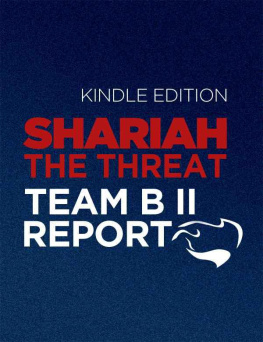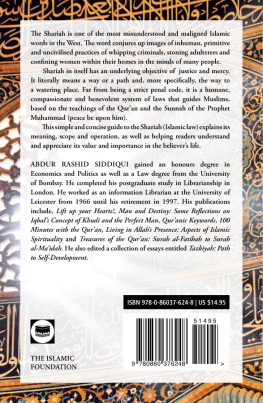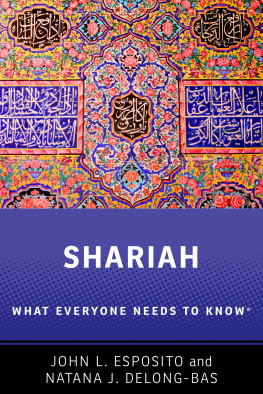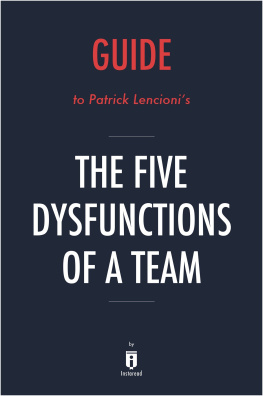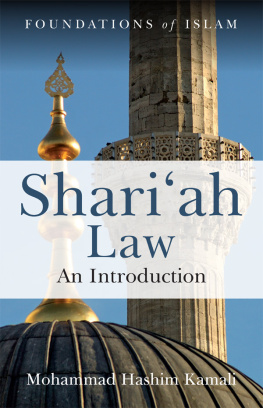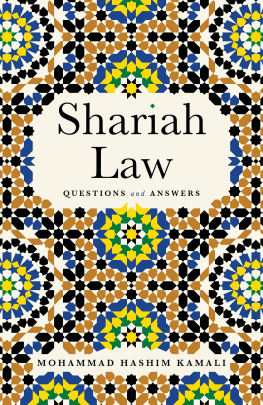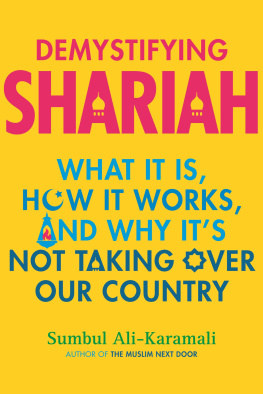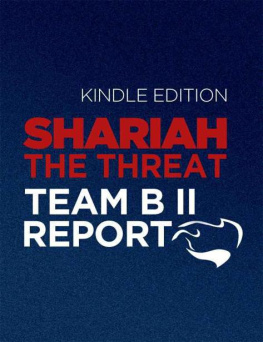Shariah
The Threat to America
An Exercise in Competitive Analysis
Report of Team B II
Copyright 2010 Center for Security Policy
October 2010 Edition
For more information about this book visit shariahthethreat.org
Shariah: The Threat to America, An Exercise in Competitive AnalysisReport of Team B II is published in the United States by the Center for Security Policy Press, a division of the Center for Security Policy.
PREFACE
This study is the result of months of analysis, discussion and drafting by a group of top security policy experts concerned with the preeminent totalitarian threat of our time: the legal-political-military doctrine known within Islam as shariah . It is designed to provide a comprehensive and articulate second opinion on the official characterizations and assessments of this threat as put forth by the United States government.
The authors, under the sponsorship of the Center for Security Policy, have modeled this work on an earlier exercise in competitive analysis which came to be known as the Team B Report. That 1976 document challenged the then-prevailing official U.S. government intelligence (Team A) estimates of the intentions and offensive capabilities of the Soviet Union and the policy known as dtente that such estimates ostensibly justified.
Unlike its predecessor, which a group of independent security policy professionals conducted at the request and under the sponsorship of the Director of Central Intelligence, George H.W. Bush, the present Team B II report is based entirely on unclassified, readily available sources. As with the original Team B analysis, however, this study challenges the assumptions underpinning the official line in the conflict with todays totalitarian threat, which is currently euphemistically described as violent extremism, and the policies of co-existence, accommodation and submission that are rooted in those assumptions.
Special thanks are due Clare Lopez, whose efforts to transform the Team B II members various individual contributions into a seamless and powerful report are deeply appreciated.
MEMBERS OF TEAM B II
Team Leaders:
Lieutenant General William G. Jerry Boykin: US Army (Ret.), former Deputy Undersecretary of Defense for Intelligence
Lieutenant General Harry Edward Soyster: US Army (Ret.), former Director, Defense Intelligence Agency
Associates:
Christine Brim: Chief Operating Officer, Center for Security Policy
Ambassador Henry Cooper: Former Chief Negotiator, Defense and Space Talks, former Director, Strategic Defense Initiative
Stephen C. Coughlin, Esq.: Major (Res.) USA, former Senior Consultant, Office of the Joint Chiefs of Staff
Michael Del Rosso: Senior Fellow, Claremont Institute and Center for Security Policy
Frank J. Gaffney, Jr.: Former Assistant Secretary of Defense for International Security Policy (Acting), President, Center for Security Policy
John Guandolo: Former Special Agent, Counter-Terrorism Division, Federal Bureau of Investigation
Brian Kennedy: President, Claremont Institute
Clare M. Lopez: Senior Fellow, Center for Security Policy
Admiral James A. Ace Lyons: US Navy (Ret.), former Commander-in-Chief, Pacific Fleet
Andrew C. McCarthy: Former Chief Assistant U.S. Attorney; Senior Fellow, National Review Institute; Contributing Editor, National Review
Patrick Poole: Consultant to the military and law enforcement on anti-terrorism issues
Joseph E. Schmitz: Former Inspector General, Department of Defense
Tom Trento: Executive Director, Florida Security Council
J. Michael Waller: Annenberg Professor of International Communication, Institute of World Politics, and Vice President for Information Operations, Center for Security Policy
Diana West: Author and columnist
R. James Woolsey: Former Director of Central Intelligence
David Yerushalmi, Esq.: General Counsel to the Center for Security Policy
Introduction
In 1976, the then-Director of Central Intelligence, George H. W. Bush, commissioned an Experiment in Competitive Analysis. Its purpose was to expose to critical scrutiny the assumptions and factual basis underpinning the official assessment of the totalitarian ideology that confronted America at the time: Soviet Communism. That official assessment was rooted in the belief that, through a policy of engagement known as dtente , the United States and the USSR could not only avoid horrifically destructive conflicts, but could peacefully coexist permanently.
DCI Bush invited a group of known skeptics about dtente to review the classified National Intelligence Estimates and other data concerning Soviet objectives, intentions and present and future military capabilities. The object was to provide an informed second opinion on the U.S. policy toward the Kremlin that was, ostensibly, warranted in light of such information. The conclusions of this experimental initiative which came to be known popularly as the Team B study differed sharply from those of Team A: the Ford Administration and the intelligence community.
Team B found that the Soviet Union was, pursuant to its ideology, determined to secure the defeat of the United States and its allies and the realization of the worldwide triumph of Soviet Communism. As a result Team B found that not only was dtente unlikely to succeed the way the U.S. government had envisioned, but the U.S. national security posture and policies undertaken in its pursuit were exposing the nation to grave danger.
The effect of this authoritative alternative view was profound. Among others, former California Governor Ronald Reagan used the thrust of its findings to challenge dtente and those in public office who supported this doctrine. Drawing on the thinking of Team B with regard to national security issues, Reagan nearly defeated President Gerald Fords bid for reelection in the 1976 primaries. Four years later, Reagan successfully opposed President Jimmy Carter, with their disagreement over the latters d tentist foreign and defense policies towards Moscow featuring prominently in the formers victory.
Most importantly, as President, Ronald Reagan drew on the work of Team B as an intellectual foundation for his strategy for destroying the Soviet Union and discrediting its ideology a feat begun during his tenure and finally accomplished, thanks to his implementation of that strategy, several years after he left office.
The Contemporary Threat
Today, the United States faces what is, if anything, an even more insidious ideological threat: the totalitarian socio-political doctrine that Islam calls shariah. Translated as the path, shariah is a comprehensive legal and political framework. Though it certainly has spiritual elements, it would be a mistake to think of shariah as a religious code in the Western sense because it seeks to regulate all manner of behavior in the secular sphere economic, social, military, legal and political.
Shariah is the crucial fault line of Islams internecine struggle. On one side of the divide are Muslim reformers and authentic moderates figures like Abdurrahman Wahid, the late president of Indonesia and leader of the worlds largest libertarian Muslim organization, Nahdlatul Ulama whose members espouse the Enlightenments embrace of reason and, in particular, its separation of the spiritual and secular realms. On this side of the divide, shariah is a reference point for a Muslims personal conduct, not a corpus to be imposed on the life of a pluralistic society.
By contrast, the other side of the divide is dominated by Muslim supremacists, often called Islamists. Like erstwhile proponents of Communism and Nazism, these supremacists some terrorists, others employing stealthier means seek to impose a totalitarian regime: a global totalitarian system cloaked as an Islamic State and called a caliphate. On that side of the divide, which is the focus of the present study, shariah is an immutable, compulsory system that Muslims are obliged to install and the world required to adopt, the failure to do so being deemed a damnable offence against Allah. For these ideologues, shariah is not a private matter. Adherents see the West as an obstacle to be overcome, not a culture and civilization to be embraced, or at least tolerated. It is impossible, they maintain, for alternative legal systems and forms of governments peacefully to coexist with the end-state they seek.
Next page
